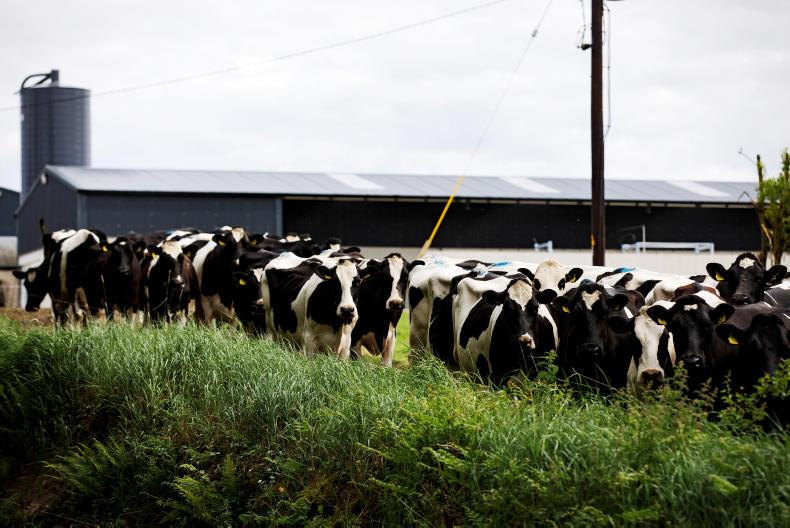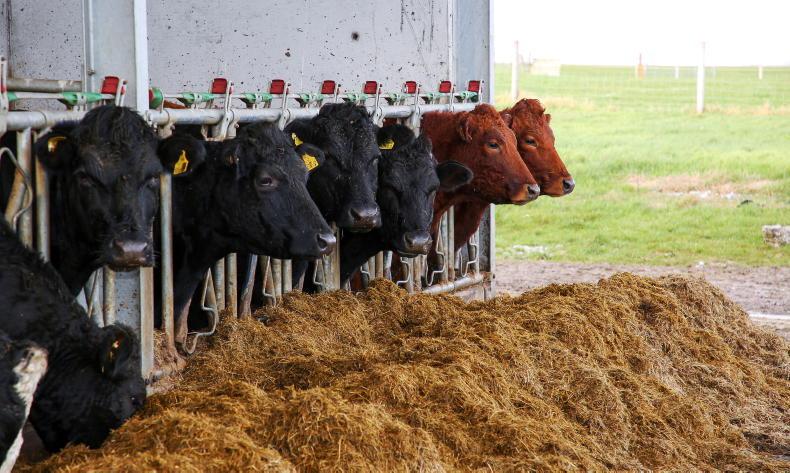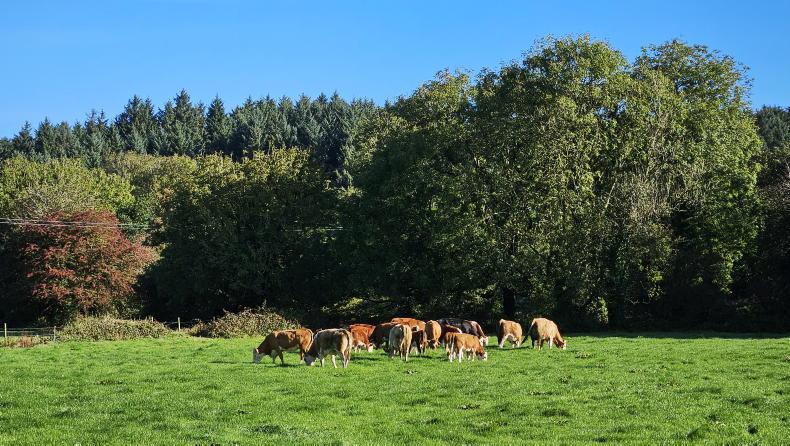When you have four conversations with different farmers and vets in the one day about the same problem, then it’s time to write about it. The problem in question relates to milk drop and coughing dairy cows.
If cows have a significant milk drop at herd level, this must be investigated.
The diet must be assessed for any changes and the components of milk can give indications about issues with energy or fibre
The first thing to look at is the cows themselves, checking body condition, dung, lameness or any clinical symptoms at herd level. Are there any reasons why the herd’s immunity might be dropping?
The diet must be assessed for any changes and the components of milk can give indications about issues with energy or fibre. At grazing time, parasites are always a concern. .
What causes a cow to cough?
Anything that irritates the windpipe or lungs can cause coughing. We refer to this as upper respiratory disease, and where the lung soft tissue is involved we refer to this as pneumonia. The three common causes of coughing at this time of year are :
Lungworm.Viruses IBR, RSV, PI3.Bacteria.Viruses such as IBR cause inflammation and irritation in the upper airways, which can lead to coughing. Bacteria tend to cause issues deeper in the lungs.
They cause less coughing but more chronic damage.
In my experience, the most severe coughing is caused by lungworm
Lungworm cause coughing by physical irritation and also due to an allergic reaction. In my experience, the most severe coughing is caused by lungworm.
A lot of coughing can be caused by all of the above agents.
Often at this time of year coughing is started by lungworm and then viruses that are circulating in the herd or bacteria proliferate, causing more prolonged problems.
How much coughing is a problem?
While we wouldn’t worry about the odd cough, it is when coughing becomes persistent that we start getting concerned.
With dairy cows, this often will be noticed when they are being moved or coming in to be milked.
We especially take notice if this is accompanied by milk drops, more sick cows and symptoms such as nasal discharges.
What other symptoms raise alarms?
If you notice increased incidences of sick cows requiring treatment for pneumonia. If herd milk production is dropping or other factors such as fertility are being affected. If cows have nasal discharges or temperatures.Can time of year or type of cough tell us anything?
Making presumptions can be dangerous. I’ve seen people vaccinate for IBR or dose for lungworm based on a cough alone.
When they get a poor response they wonder did the product work. Match the solution to the problem.
The type of cough and time of year can give us indications of what might be happening.
Lungworm is predominantly a pasture problem from June on.
A lungworm-related cough tends to often be very deep and, when there are no viral/bacterial infections present, without major nasal discharges.
Of course, timing can give us indications as well. Lungworm is predominantly a pasture problem from June on.
When we see cows coughing at housing or around calving I’m always more suspicious of viral infections.
Where do we start when investigating the problem?
After looking at the cows to rule out obvious problems that might be affecting their immunity, we look at clinical symptoms.
In summer months with coughing cows we can take faecal samples to check for lungworm, bloods, nasal swabs or lung washes for more accurate diagnosis.
At calving time we tend to look more at bloods, nasal swabs and looking at underlying nutritional stressors
We should also look at the diet and check the bulk herd protein levels for any fluctuations. Also butterfat should not fluctuate massively, and we need to watch rumination and dung.
At calving time we tend to look more at bloods, nasal swabs and looking at underlying nutritional stressors.
Your own vet is best placed to figure out where to start.
Should cows not have immunity to lungworm?
The traditional thinking was that once immunity was developed animals would have it for life. However, with dairy cows this is no longer always the case.
Why?
Young stock are being so well dosed their ability to create natural immunity to lungworm is impaired. This means when they enter the milking herd they are more susceptible.
I am also seeing this where heifers are being contract-reared in farms where there is very little exposure to parasites.
When they return to the home farm they will pick up the parasites.
Ideally we want younger animals to develop immunity over time to low levels of lungworm.
We also have seen reinfection syndrome. With lungworm there are two levels of immunity – at the gut where the parasite enters the body and at the lungs.
With reinfection syndrome, larvae get to the lungs because of short gut immunity and do not develop into adults because of lifelong immunity at lung level
The immunity in the lungs is lifelong while the gut immunity wears off after a year.
With reinfection syndrome, larvae get to the lungs because of short gut immunity and do not develop into adults because of lifelong immunity at lung level.
This can be difficult to diagnose because, as the larvae don’t fully develop into adults, no eggs/larvae are produced to be detected in faecal tests.
These are the coughing cows with milk drop that have negative faecal samples for lungworm.
These cases often need lung washes to diagnose.
Are there any problems with dosing frequently?
It is one way to control lungworm in adult cows but an unsustainable one, I feel.
We are facing serious concerns around resistance and it can be very costly.
We should only ever dose adult cows based on a need for the dose
There is only one product available for worming lactating cows or one active ingredient. If resistance develops to this, then we have limited options.
We should only ever dose adult cows based on a need for the dose.
The target is always to minimise worm dosing, while not affecting herd performance.
Pour-on or injection for milkers?
Both have their advantages, with pour-ons easier to use while the injections present a lower risk of human error. My opinion is pour-on can often be rushed and I have seen poor application techniques.
When using pour-ons, use the correct amount and apply slowly on to dry cows.
With heavy lungworm infections, the coughing can get worse after treatment and severe cases may require steroids and antibiotics.
This is why consulting your vet around treatments is so important.
What role does grazing and weather play?
In mild wet summers, lungworm levels in pasture can spike quickly.
Add in a tight grazing system (4cm post-grazing height) and heavy stocking densities and we have big contributing factors in some farms.
Rainwater splashes the larvae from the dung on to the grass to be ingested.
Might it be two problems, one cough?
Yes, on many occasions I’ve seen this. At calving time or in early spring it can be nutritional stress with viral infections, for example.
During the grazing season it could be lungworm and viral infection.
Where cows start with a lungworm problem, over time secondary viral and bacterial infections can also affect cows.
Is this a new phenomenon?
It’s probably not all that new but we have seen a notable increase over the last eight to 10 years.
However, there is no doubt that worming strategies in young stock, weather conditions and increased intensification have sped up the process.
If you are treating your dairy herd on multiple occasions (three times or more during the grazing season) with eprinomectin, ask yourself if you have an issue. Use this sign as a trigger to talk to your vet.
Vaccination seems to have a place
With lungworm we want animals to build immunity over time.
The lungworm oral vaccine, one of the oldest cattle vaccines, seems to have a place in the future of farm control programmes.
This needs to be given twice to calves four weeks apart and after eight weeks of age.
It can be used as a booster before turnout for yearling heifers as well.
Problem herds now need to consider how this vaccine can reduce your dependency on eprinomectin to control lungworm.
When you have four conversations with different farmers and vets in the one day about the same problem, then it’s time to write about it. The problem in question relates to milk drop and coughing dairy cows.
If cows have a significant milk drop at herd level, this must be investigated.
The diet must be assessed for any changes and the components of milk can give indications about issues with energy or fibre
The first thing to look at is the cows themselves, checking body condition, dung, lameness or any clinical symptoms at herd level. Are there any reasons why the herd’s immunity might be dropping?
The diet must be assessed for any changes and the components of milk can give indications about issues with energy or fibre. At grazing time, parasites are always a concern. .
What causes a cow to cough?
Anything that irritates the windpipe or lungs can cause coughing. We refer to this as upper respiratory disease, and where the lung soft tissue is involved we refer to this as pneumonia. The three common causes of coughing at this time of year are :
Lungworm.Viruses IBR, RSV, PI3.Bacteria.Viruses such as IBR cause inflammation and irritation in the upper airways, which can lead to coughing. Bacteria tend to cause issues deeper in the lungs.
They cause less coughing but more chronic damage.
In my experience, the most severe coughing is caused by lungworm
Lungworm cause coughing by physical irritation and also due to an allergic reaction. In my experience, the most severe coughing is caused by lungworm.
A lot of coughing can be caused by all of the above agents.
Often at this time of year coughing is started by lungworm and then viruses that are circulating in the herd or bacteria proliferate, causing more prolonged problems.
How much coughing is a problem?
While we wouldn’t worry about the odd cough, it is when coughing becomes persistent that we start getting concerned.
With dairy cows, this often will be noticed when they are being moved or coming in to be milked.
We especially take notice if this is accompanied by milk drops, more sick cows and symptoms such as nasal discharges.
What other symptoms raise alarms?
If you notice increased incidences of sick cows requiring treatment for pneumonia. If herd milk production is dropping or other factors such as fertility are being affected. If cows have nasal discharges or temperatures.Can time of year or type of cough tell us anything?
Making presumptions can be dangerous. I’ve seen people vaccinate for IBR or dose for lungworm based on a cough alone.
When they get a poor response they wonder did the product work. Match the solution to the problem.
The type of cough and time of year can give us indications of what might be happening.
Lungworm is predominantly a pasture problem from June on.
A lungworm-related cough tends to often be very deep and, when there are no viral/bacterial infections present, without major nasal discharges.
Of course, timing can give us indications as well. Lungworm is predominantly a pasture problem from June on.
When we see cows coughing at housing or around calving I’m always more suspicious of viral infections.
Where do we start when investigating the problem?
After looking at the cows to rule out obvious problems that might be affecting their immunity, we look at clinical symptoms.
In summer months with coughing cows we can take faecal samples to check for lungworm, bloods, nasal swabs or lung washes for more accurate diagnosis.
At calving time we tend to look more at bloods, nasal swabs and looking at underlying nutritional stressors
We should also look at the diet and check the bulk herd protein levels for any fluctuations. Also butterfat should not fluctuate massively, and we need to watch rumination and dung.
At calving time we tend to look more at bloods, nasal swabs and looking at underlying nutritional stressors.
Your own vet is best placed to figure out where to start.
Should cows not have immunity to lungworm?
The traditional thinking was that once immunity was developed animals would have it for life. However, with dairy cows this is no longer always the case.
Why?
Young stock are being so well dosed their ability to create natural immunity to lungworm is impaired. This means when they enter the milking herd they are more susceptible.
I am also seeing this where heifers are being contract-reared in farms where there is very little exposure to parasites.
When they return to the home farm they will pick up the parasites.
Ideally we want younger animals to develop immunity over time to low levels of lungworm.
We also have seen reinfection syndrome. With lungworm there are two levels of immunity – at the gut where the parasite enters the body and at the lungs.
With reinfection syndrome, larvae get to the lungs because of short gut immunity and do not develop into adults because of lifelong immunity at lung level
The immunity in the lungs is lifelong while the gut immunity wears off after a year.
With reinfection syndrome, larvae get to the lungs because of short gut immunity and do not develop into adults because of lifelong immunity at lung level.
This can be difficult to diagnose because, as the larvae don’t fully develop into adults, no eggs/larvae are produced to be detected in faecal tests.
These are the coughing cows with milk drop that have negative faecal samples for lungworm.
These cases often need lung washes to diagnose.
Are there any problems with dosing frequently?
It is one way to control lungworm in adult cows but an unsustainable one, I feel.
We are facing serious concerns around resistance and it can be very costly.
We should only ever dose adult cows based on a need for the dose
There is only one product available for worming lactating cows or one active ingredient. If resistance develops to this, then we have limited options.
We should only ever dose adult cows based on a need for the dose.
The target is always to minimise worm dosing, while not affecting herd performance.
Pour-on or injection for milkers?
Both have their advantages, with pour-ons easier to use while the injections present a lower risk of human error. My opinion is pour-on can often be rushed and I have seen poor application techniques.
When using pour-ons, use the correct amount and apply slowly on to dry cows.
With heavy lungworm infections, the coughing can get worse after treatment and severe cases may require steroids and antibiotics.
This is why consulting your vet around treatments is so important.
What role does grazing and weather play?
In mild wet summers, lungworm levels in pasture can spike quickly.
Add in a tight grazing system (4cm post-grazing height) and heavy stocking densities and we have big contributing factors in some farms.
Rainwater splashes the larvae from the dung on to the grass to be ingested.
Might it be two problems, one cough?
Yes, on many occasions I’ve seen this. At calving time or in early spring it can be nutritional stress with viral infections, for example.
During the grazing season it could be lungworm and viral infection.
Where cows start with a lungworm problem, over time secondary viral and bacterial infections can also affect cows.
Is this a new phenomenon?
It’s probably not all that new but we have seen a notable increase over the last eight to 10 years.
However, there is no doubt that worming strategies in young stock, weather conditions and increased intensification have sped up the process.
If you are treating your dairy herd on multiple occasions (three times or more during the grazing season) with eprinomectin, ask yourself if you have an issue. Use this sign as a trigger to talk to your vet.
Vaccination seems to have a place
With lungworm we want animals to build immunity over time.
The lungworm oral vaccine, one of the oldest cattle vaccines, seems to have a place in the future of farm control programmes.
This needs to be given twice to calves four weeks apart and after eight weeks of age.
It can be used as a booster before turnout for yearling heifers as well.
Problem herds now need to consider how this vaccine can reduce your dependency on eprinomectin to control lungworm.









SHARING OPTIONS